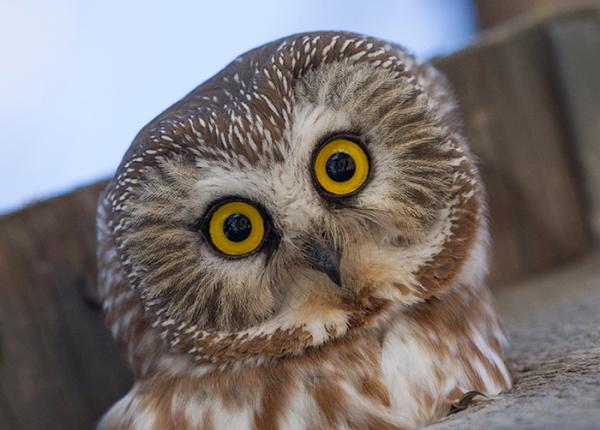Did You Know?
- The Northern Saw-whet Owl is mentioned in the Grateful Dead song "Unbroken Chain." The lyrics go like this: "Lilac rain, unbroken chain, Song of the Saw-Whet owl, Out on the mountain, it'll drive you insane, Listening to the winds howl"
- Some scientists believe that, because of its highly developed ears, the Northern Saw-whet Owl, just like the Barn Owl, might be able to hunt in complete and total darkness.
How The Peregrine Fund is Helping
Though The Peregrine Fund doesn't work directly with Northern Saw-whet Owls, our efforts in scientific research, habitat conservation, education, and community development help conserve birds of prey around the world. We also supply literature to researchers from our avian research library, which helps scientists around the world gather and share important information on raptor conservation.
Where They Live
The Northern Saw-whet Owl makes its home throughout much of North America. From boreal forests of south central Alaska, to old growth forests, grasslands and riparian areas of much of Canada and the contiguous United States, to the fir and pine-oak forests of parts of Mexico - this small owl really gets around!
The Northern Saw-whet Owl's year-round range extends from coastal south-eastern Alaska through most of southern Canada. It continues south into the Great Lakes states, New England, and the western United States all the way south to the central highlands of Mexico. Though some birds may remain within this range year-round, other individuals expand their range in winter heading into the central part of the U.S.A. According to scientists, young birds are more likely to migrate than the adults.
No matter if they are on their breeding grounds or searching for a place to spend the cold, winter months, Northern Saw-whet Owls often can be found in forests where deciduous and coniferous trees grow, but that also have a shrubby undergrowth. During breeding season, in particular, scientists believe that these owls will pick a nesting spot that is in or near to a swamp or riparian area. In winter they have also been observed in more open areas.
What They Do
Let's face it. It is hard to be any more adorable than a Northern Saw-whet Owl. Their big yellow eyes, disproportionately large heads, and almost cat-like faces give them an extra dose of cuteness that is unrivaled by most. Unlike the Western Screech-owl, Northern Saw-whet Owls don't have any ear tufts. Their facial disk is a light, buffy color and their backs are a darker brown speckled with white dots, almost as if someone splattered paint on them. Their bellies are white with brownish streaking.
Juvenile Northern Saw-whet Owls look quite different than the adults. Young owls have distinctly darker heads with a white patch above their eyes, while their bodies are buffy colored.
The Northern Saw-whet Owl tends to vocalize only during the breeding season which lasts from March to May. It is mostly silent throughout the rest of the year. When it does call, it, like most owls, has a full repertoire of hoots and whoops at its disposal. In fact, the Saw-whet Owl may have gotten its name because one its vocalizations has a very metallic quality - sounding like "saw whetting" or the sharpening of a saw!
Like many owl species, the Northern Saw-whet Owl is nocturnal, meaning it is most active at night. Around dusk, when most of us are just starting to wind down for the day, this owl's day is just starting. At this time, these owls wake up from their roost spot, stretch their wings and get ready for a night of hunting and feeding. The owls likely rest during the middle of the night and might become active again right at dawn, perhaps when many of us are still asleep. Once the sun rises, the owls will look for a safe place to roost - usually in a dense tree where their color patterns help them easily blend in with the surrounding tree branches, helping them to remain undetected by other predators who hunt during the day.
Now, in order to help them maneuver in the dark, owls are equipped with some very special characteristics. First, their large eyes help them see in low light. Their eyes are so large, they have a bony ring around the eye, which protects the eye and gives it shape. This ring, known as the sclerotic ring, also keeps the eye in place so that owls are unable to move their eyes. If they want to look right or left they have to move their entire heads. So owls have a long neck and are able to rotate their heads more than 180 degrees from a forward position.
Apart from their amazing eyesight, owls are also blessed with wonderful hearing thanks, in part, to their asymmetrical ear openings. If one were to examine the skull of the Northern Saw-whet Owl, they would notice that the right ear is higher on the head than the left, and each ear opening is a different shape. Asymmetrical ears help owls pinpoint the direction of a noise, making them experts at knowing the exact position of prey animal - whether it is a rodent moving beneath the snow or a bird rustling its feathers.
Why They Need our Help
The Northern Saw-whet Owl is considered to be of "Least Concern," which generally means that populations throughout its range are stable and that the species is relatively common. However, habitat loss due to logging and other actions may seriously threaten its nesting/breeding habitat. It is estimated that populations of this small owl have probably declined, but it is a difficult species to study, mainly because of its secretive nature and its nocturnal habits.
This owl may also fall prey to predators - including larger owls, such as the Great-horned Owl.
What They Eat
As you know, the Northern Saw-whet Owl is a nocturnal predator - it most often can be found hunting in the dim light of dusk and dawn. It feeds mostly on small rodents such as deer mice, squirrels, voles and moles. But, their choices don't stop there. These owls will also happily eat small to medium-sized birds such as sparrows, swallows, kinglets, juncos, bright red Northern Cardinals and even some doves. They will also feed on frogs and a number of different insects. One study done on the Queen Charlotte Islands of British Colombia found remains of intertidal invertebrates (meaning worms, insects, crustaceans, and the like that live in intertidal habitats such as mangroves and salt marshes) in the stomachs of road-killed Saw-whet Owls.
When hunting, Saw-whet Owls will often jump or pounce upon their prey. They have been known to catch many mice at once when there is a lot of food available. Though they can't eat that many mice in one sitting, they will store, or cache, the food for later.
Nests, Eggs, and Young
Scientists believe that Saw-whet Owls are not monogamous, meaning they do not keep the same mate for life. Instead, each year the male must find a new female to raise young with. It isn't an easy job attracting a female, especially if there is a lot of competition. This is when Saw-whet Owls break out all the stops, polish off their vocal cords, and begin to sing. Once a female is enticed in by a male's call, she will respond with her own calls. The male might then present her with a gift. But instead of flowers or chocolates, he proudly gives her a dead mouse or other prey, which he carries to her in his beak. These owls have been observed allopreeing - which is when the males and females clean each others' feathers. This might be a way to help form a pair bond during the breeding season. Though more documentation is needed, scientists believe that this species sometimes engages in what is known as "sequential polyandry." Polyandry is when a female of a species has more than one male as a mate. It is known as "sequential" because, in the case of the Northern Saw-whet Owl, the female sort of staggers her mates. Specifically, after the young from her first brood hatch, the female may leave the male to raise this group of young on his own, while she then finds a second mate to pair with. She will then lay a second clutch of eggs with this second male.
Saw-whet Owls don't build their own nests. Instead, they rely on old holes left by woodpeckers in which to lay their eggs. It is usually the female that chooses the nest site within the male's territory. Nesting cavities aren't usually very high ranging from 2-12 m from the ground. They will also nest in natural tree cavities and even man-made nest boxes.
The female lays 4-7 eggs which she must incubate for the next 27-29 days. During this time, the male is busy finding food for himself and the female. After the chicks hatch, they keep their eyes closed for the first week to ten days. During this time, the female broods her young - covering them with her body to make sure they are protected from the elements and kept warm. The male must also continue to work hard, as he now has many extra mouths to feed. He will bring the food to the nest and the female will rip it into tiny pieces, delicately feeding each chick. As the chicks get a bit older, they are able to grasp and tear their own food. After about 4-5 weeks in the nest, the young will fledge, or fly for the first time. But, they are still dependent on their parents for up to two more months. These young owls may be able to reproduce in their first year.
Idaho Connection
While this species is often found in the most heavily forested areas of Idaho, Northern Saw-whet Owls are believed to be somewhat common throughout the state.
Northern Saw-whet Owl and the World Center for Birds of Prey
If you are very lucky, you just might spot a wild Northern Saw-whet Owl perched in one of the trees around our World Center for Birds of Prey. Though not seen too often, our staff have observed and photographed at least one individual right next to the parking lot! Additionally, the visitor center at our World Center for Birds of Prey includes owls among its avian ambassadors. Though we do not have a Northern Saw-whet owl in our avian ambassador family, we do have a lovely Eurasian Eagle Owl that enjoys visitors. This is a great chance to see owls up close and learn about the wonderful and interesting adaptations they have in order to survive in their respective habitats. There is also a touch table with owl feathers and other natural objects available for exploration.
References:
https://www.allaboutbirds.org/guide/Northern_Saw-whet_Owl/lifehistory
http://animaldiversity.org/accounts/Aegolius_acadicus/#d5f934cadcb8c8ca368279f514904d19
http://www.azlyrics.com/lyrics/gratefuldead/unbrokenchain.html
Cannings, R. 1993. Northern saw-whet owl (Aegolius acadicus). Pp. 1-20 in A Poole, F Gill, eds. The Birds of North America, Vol. 42. Philadelphia, PA: The Academy of Natural Sciences and Washington DC: The American Ornithologists Union.
Hobson, K., & Sealy, S. (1991). Marine Protein Contributions to the Diet of Northern Saw-Whet Owls on the Queen Charlotte Islands: A Stable-Isotope Approach. The Auk, 108(2), 437-440. Retrieved from http://www.jstor.org/stable/4087972
Johnsgard, Paul A, 1988, North American Owls Biology and Natural History, Smithsonian Institution Press, Washington. Long, Kim,1998, Owls: A Wildlife Handbook, Johnson Printing, Colorado.
Rasmussen, J. L., S. G. Sealy, and R. J. Cannings (2020). Northern Saw-whet Owl (Aegolius acadicus), version 1.0. In Birds of the World (A. F. Poole, Editor). Cornell Lab of Ornithology, Ithaca, NY, USA. https://doi.org/10.2173/bow.nswowl.01









